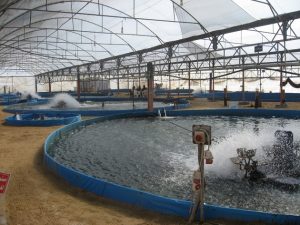Biofloc Technology
- Biofloc technology (BT) is a fish farming system in which aggregates of bacteria, algae, or protozoa, held together in a matrix along with particulate organic matter are used in order to improve water quality, waste treatment and disease prevention in intensive aquaculture systems’.
- The technique recycles waste nutrients as fish food as consumption of bioflocs also provides nutritional value to cultured aquatic species.
- Thus BT can be an ideal option for sustainable and environmentally friendly aquaculture.
- BT is used in large-scale shrimp and finfish farms, mainly in Asia.
- Tilapia is currently among the most common species farmed in biofloc systems, since they are able to take up bioflocs as an additional protein source, resulting in a considerable reduction in production inputs.
Role of Microorganisms
- The flocs of bacteria are a nutrient-rich source of proteins and lipids, providing food for the fish throughout the day.
- The water column shows a complex interaction between living microbes, planktons, organic matter, substrates, and grazers, which serves as a secondary source of food.
- The combination of these particulate matters keeps the recycling of nutrients and maintains the water quality.
- The consumption of flocs by cultured organisms increase the immunity and growth rate, decrease feed conversion ratio, and reduce the overall cost of production.
Species Compatibility
In this technique, specifically cultured microorganisms are introduced into the water to form microbial protein from toxic fish waste and other organic matter. This maintains water quality as well as lowering costs.
Therefore, candidate species must be:
- Resistant to environmental changes,
- Resistant to high stocking density,
- Adaptable to changes in dissolved oxygen, and
- Omnivores or able to take microbial protein as food.

Advantage of Biofloc Technology
This technique has following benefits:
- It prevents the introduction of disease to fish from incoming water by improving water quality.
- Improve biosecurity.
- Improve feed conversion.
- Improve water-use efficiency.
- Increase land-use efficiency.
- Reduce sensitivity to light fluctuations.